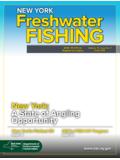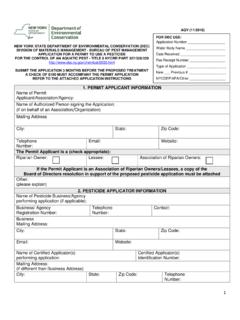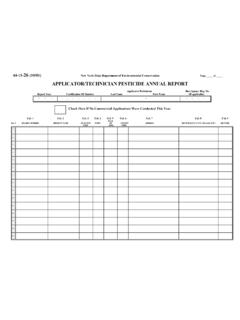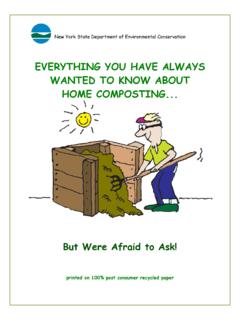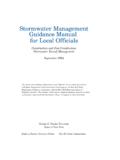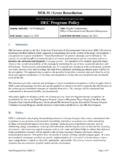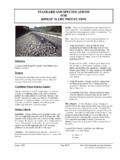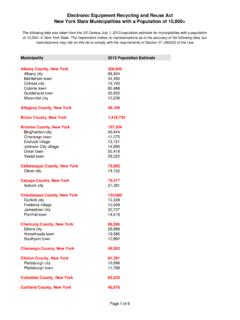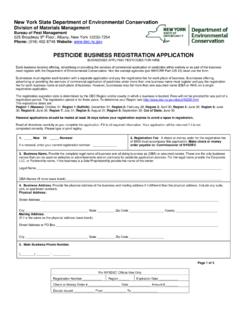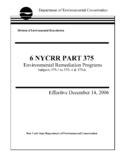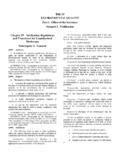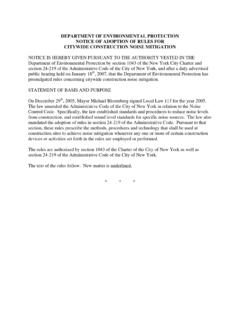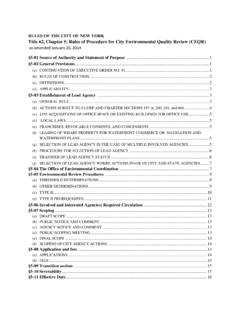Transcription of 6 NYCRR Part 599 - Standards for New Hazardous Substance ...
1 6 NYCRR PART 599. Standards FOR NEW Hazardous Substance TANK SYSTEMS. (Statutory authority: environmental Conservation Law sections 1-0101, 3-0301, 3-0303, 17-0301, 17-0303, 17-0501, 17-1743, 37-0101 through 37-0107, and 40-0101 through 40-0121). TABLE OF CONTENTS. General ..2. General requirements for underground tank systems ..3. New underground tanks ..4. Secondary containment for underground tanks ..6. Monitoring at new underground tanks ..8. Installation of underground tank systems ..8. General requirements for aboveground tank systems ..10. New aboveground tanks ..10. Secondary containment for aboveground tanks ..13. Monitoring systems for new aboveground tanks ..16. Installation of aboveground tank systems ..16. General requirements for piping ..18. New piping.
2 18. Secondary containment for on-ground and underground piping ..21. Monitoring of new on-ground and underground piping ..23. Installation of piping ..23. Spill and overfill prevention ..24. Venting, and pressure/vacuum/thermal 6 NYCRR Part 599 Oct. 11, 2015 Page 1 of 29. General. (a) Purpose. This Part sets forth Standards for all new tank systems. (b) Applicability. (1) This Part applies to facilities described under section (b) of this Title. (2) Beginning on February 11, 1995, all new tank systems must be constructed, designed and installed pursuant to the provisions of this Part. (c) Definitions. The definitions found in section (c) of this Title shall apply to this Part. (d) Severability. If any provision of this Part or its application to any person or circumstance is held to be invalid, the remainder of this Part and the application of that provision to other persons or circumstances shall not be affected.
3 (e) Variances. (1) The department may, upon written request from any person subject to this Part, grant a variance from one or more specific provisions of this Part. An application for a variance must: (i) identify the specific provisions of this Part from which a variance is sought;. (ii) demonstrate that compliance with the identified provisions would, on the basis of conditions unique to the person's particular situation, tend to impose a substantial economic, technological or safety burden on the person; and (iii) demonstrate that the proposed activity will have no significant adverse impact on the public health, safety, welfare or the environment and will be consistent with the provisions of the ECL and the performance expected from application of this Part. (2) The department may not grant any variance which would result in regulatory controls less stringent than those in 40 CFR parts 280 and 281 (see section (j) of this Title).
4 (3) In granting any variance, the department may impose specific conditions necessary to assure that the subject activity will have no significant adverse impact on the public health, safety, welfare or the environment. (f) Confidentiality. Any person submitting information to the department pursuant to this Part may, at the time of submission, request that the department exempt such information from disclosure under paragraph (d) of subdivision (2) of section 87 of the Public Officers Law. 6 NYCRR Part 599 Oct. 11, 2015 Page 2 of 29. (f). All requests under this section must be made in accordance with the provisions of section of this Title and all determinations will be made pursuant to that section. (g) Enforcement. Any person who violates any of the provisions of this Part, or any order issued by the department, shall be liable for the civil, administrative and criminal penalties set forth in article 71 of the environmental Conservation Law.
5 (h) References. Citations used in this Part refer to the publications listed in section (j) of this Title. These publications are available for inspection at the Department of environmental Conservation, 625 Broadway, Albany, NY 12233-7020. (i) Access to records and tank systems. Any designated officer or employee of the department shall have the right of access as provided in section (e) of this Title. (j) Use of equivalent technology. Where specified in this Part, the department may approve the use of an equivalent technology method or practice by any person subject to this Part. A request to use equivalent technology must: (1) identify the applicable provision of this Part;. (2) include evidence, including but not limited to data, plans, specifications and test results that demonstrate that the technology, method or practice desired to be used will protect the public health, safety and welfare and the environment in a manner which equals or exceeds the requirements of the applicable provision of this Part.
6 General requirements for underground tank systems. (a) New underground tank systems - summary of requirements. Beginning on February 11, 1995, owners and operators of new underground tanks must meet the following requirements: (1) tanks must be designed in accordance with section of this Part;. (2) secondary containment must be designed, constructed and installed as specified in section of this Part;. (3) a leak monitoring system must be installed as specified in sections and of this Part;. (4) tank systems must be installed as specified in section of this Part;. (5) New piping being connected to the tank must be designed, constructed and installed as specified in sections through of this Part;. 6 NYCRR Part 599 Oct. 11, 2015 Page 3 of 29. (a). (6) spill/overfill prevention equipment must be installed as specified in section of this Part; and (7) vents, gauges and alarms must be installed as specified in section of this Part.
7 (b) Compliance with Part 598. New tank systems must meet all of the requirements of this Part and of Part 598 of this Title before being placed in service. New underground tanks . (a) Label requirements. (1) All new underground tanks must bear a permanent stencil, label or plate with the following information: (i) a manufacturer's or qualified engineer's statement that, "This tank conforms with 6 NYCRR Part 599";. (ii) the standard of design by which the tank was manufactured;. (iii) the Hazardous substances which may be stored permanently and compatibly within the tank, or reference to a list available from the manufacturer which identifies substances compatible with all tank materials;. (iv) the year in which the tank was manufactured;. (v) the dimensions, design and working capacity, and model number of the tank; and (vi) the name of the manufacturer.
8 (2) A label which shows the information required in subdivision (a) of this section, and in section (h) of this Title, and the date of installation must be conspicuously displayed and permanently affixed at the fill port. It must be readily visible to the carrier and may be imbedded in concrete, welded to the fill port, or otherwise permanently affixed. (b) tanks subject to scouring. All new underground tanks subject to scouring by the inflow of Hazardous materials or subject to wear from manual gauging must be equipped with wear plates, diffusers or alternate means to prevent localized wear or corrosion. If wear plates are used, they must cover an area of at least 144 square inches and be installed in a manner which avoids crevice corrosion. 6 NYCRR Part 599 Oct. 11, 2015 Page 4 of 29.
9 (c). (c) Tank designs. (1) Underground tanks must be of sufficient structural strength to withstand normal handling and use. They must be compatible with the Hazardous Substance to be stored and be protected or resistant to all forms of internal and external wear, vibration, shock and corrosion. They must have a stable foundation under all operating conditions and be protected from fire, heat, vacuum and pressure which might cause tank failure. If fiberglass-reinforced- plastic material is used, the material must be of sufficient density and strength to form a hard, impermeable shell which will not crack, wick, wear, soften or separate under normal service conditions. tanks must be designed with a minimum 30 years of useful life unless a shorter life expectancy is defined in the spill prevention report.
10 (2) All new underground tanks , their welds, seams and connecting fittings must be factory tested for tightness using generally accepted engineering practices. All tanks sold in New York State must be guaranteed by the manufacturer to be tight. (3) All new underground tanks must meet the criteria of this subdivision and must be designed, constructed and installed or certified by a qualified engineer or technician in accordance with one of the following: (i) ULC Standard S603;. (ii) ASTM D4021-92 (see section (j) of this Title); or (iii) any other consensus code, practice or standard developed by a nationally recognized association or independent testing laboratory which meet the specifications of this subdivision. (d) Corrosion protection. (1) All new underground tanks which are in contact with soil and subject to corrosion must be protected from external corrosion by one of the following: (i) corrosion resistant materials; or (ii) a cathodic protection system .
